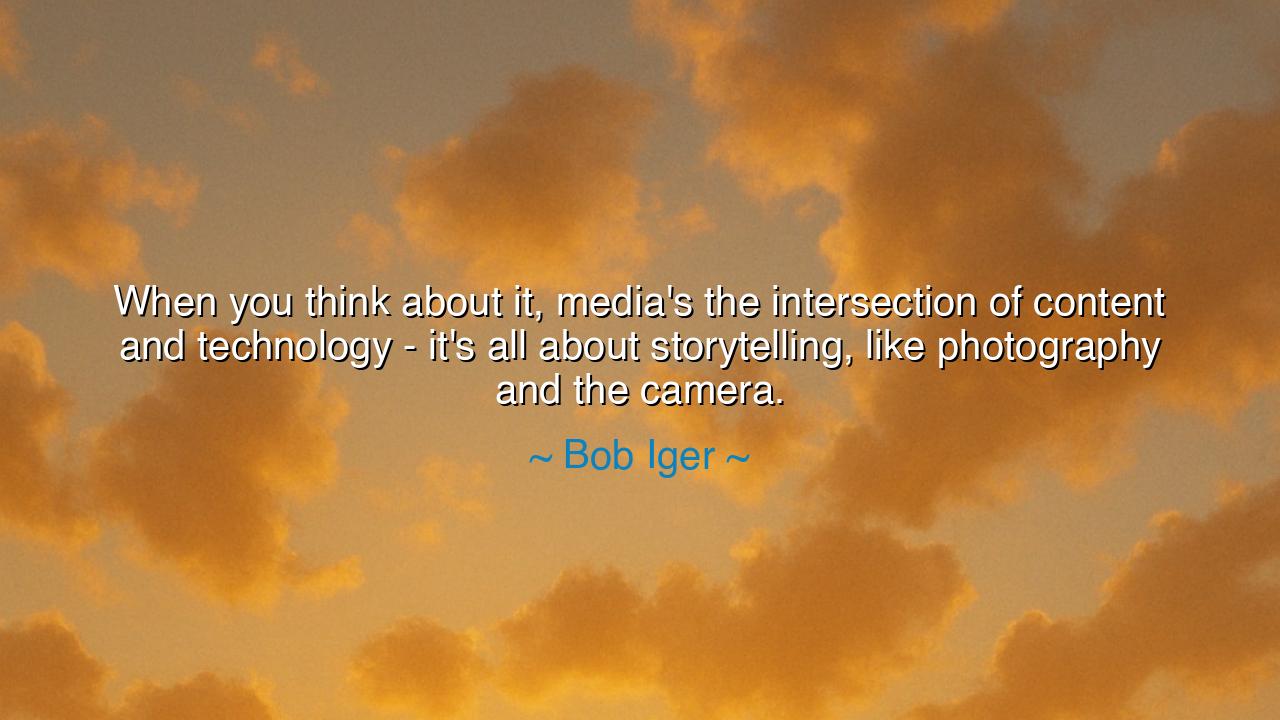
When you think about it, media's the intersection of content and
When you think about it, media's the intersection of content and technology - it's all about storytelling, like photography and the camera.






Bob Iger, a guardian of stories in the modern age, once declared: “When you think about it, media’s the intersection of content and technology—it’s all about storytelling, like photography and the camera.” His words are both simple and profound, for they reveal the eternal bond between invention and imagination. Tools alone cannot stir the soul, and words alone cannot reach the multitudes. But when the instrument of technology is wedded to the flame of content, the result is storytelling—the lifeblood of culture, the bridge between hearts, the echo that outlasts generations.
The ancients, too, knew this truth in their own way. Long before cameras, the wandering bard was the “media” of his time. His content was the epic song, his technology was the lyre. Together, they created an experience that not only entertained but preserved memory, shaping the spirit of the people. Homer, with his voice and stringed instrument, captured the fall of Troy so deeply that it still lives today. What Iger proclaims of photography and the camera was once true of harp and voice: the merging of tool and tale transforms fleeting moments into eternal meaning.
In the age of photography, this union of content and technology became visible to the eye. A story could be told not in words alone but in images—the sorrow of a war-torn child, the triumph of a nation’s flag raised on foreign soil, the tenderness of lovers captured in a single frame. The camera became the vessel, and content—the human experience—became the spirit within it. Together, they carried stories farther than the reach of a single village, imprinting them upon the hearts of millions. Thus, as Iger declares, media is not merely tool or tale, but the sacred marriage of both.
Consider the story of the printing press, that mighty invention of Gutenberg in the fifteenth century. Before it, the content of knowledge was confined to a few, guarded in monasteries and palaces. With the technology of movable type, those same words could flood across nations. The Bible, poetry, philosophy—all became accessible to the common man. This was not simply the triumph of invention, nor simply the triumph of content, but the union of both, bringing forth a revolution of storytelling that reshaped the world. What Gutenberg did with type, the camera would later do with image, and digital technology does now with sound and vision.
Yet Iger’s words are not only history—they are a guide to the present. In our time, media has multiplied into countless forms: streaming platforms, social networks, films, games. Each is a new camera, a new tool. But without meaningful content, they are hollow, as lifeless as an empty shell. And without the tool to carry it, content fades, as unrecorded speech vanishes on the wind. True power lies in their convergence, in the balance of artistry and invention, purpose and platform.
The lesson for us, then, is to respect both halves of this union. If you are a creator, pour heart into content, for without substance, technology becomes noise. If you are an innovator, craft technology that serves story, for without the human spirit, invention becomes machinery without soul. Together, these forces can preserve culture, awaken empathy, and inspire generations yet unborn.
So, dear listener, carry Bob Iger’s wisdom into your own work and life: seek always the sacred intersection where tool meets tale. Remember that the camera without vision is blind, and the story without a vessel is forgotten. But when content and technology stand united, storytelling becomes eternal, the great inheritance of humanity, passed down like fire from age to age. For in that union lies not only media, but the very way we remember, understand, and dream.






AAdministratorAdministrator
Welcome, honored guests. Please leave a comment, we will respond soon